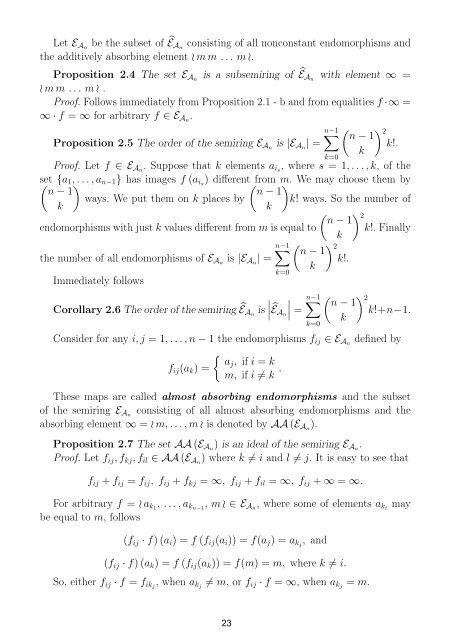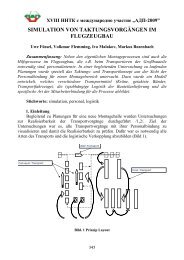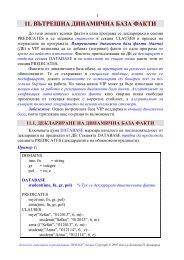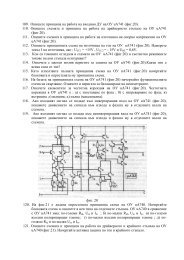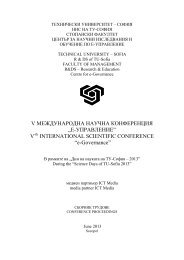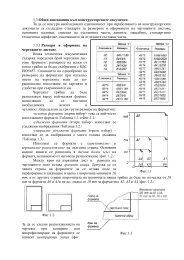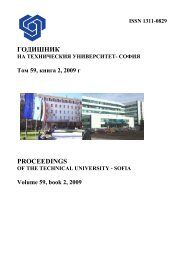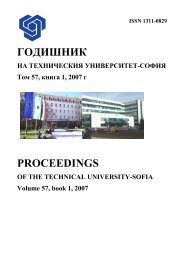described by the following join-table:∨ a b ma a m mb m b mm m m mand ÊA 3is its endomorphismsemiring. From Proposition 2.1 the elements of ÊA 3are: ≀aaa≀, ≀bbb≀, the identity≀abm≀, ≀bam≀, ≀amm≀, ≀bmm≀, ≀mam≀, ≀mbm≀ and the absorbing element ≀mmm≀.We have the following addition table:+ ≀aaa≀ ≀bbb≀ ≀abm≀ ≀bam≀ ≀amm≀ ≀bmm≀ ≀mam≀ ≀mbm≀ ≀mmm≀≀aaa≀ ≀aaa≀ ≀mmm≀ ≀amm≀ ≀mam≀ ≀amm≀ ≀mmm≀ ≀mam≀ ≀mmm≀ ≀mmm≀≀bbb≀ ≀mmm≀ ≀bbb≀ ≀mbm≀ ≀bmm≀ ≀mmm≀ ≀bmm≀ ≀mmm≀ ≀mbm≀ ≀mmm≀≀abm≀ ≀amm≀ ≀mbm≀ ≀abm≀ ≀mmm≀ ≀amm≀ ≀mmm≀ ≀mmm≀ ≀mbm≀ ≀mmm≀≀bam≀ ≀mam≀ ≀bmm≀ ≀mmm≀ ≀bam≀ ≀mmm≀ ≀bmm≀ ≀mmm≀ ≀mmm≀ ≀mmm≀≀amm≀ ≀amm≀ ≀mmm≀ ≀amm≀ ≀mmm≀ ≀amm≀ ≀mmm≀ ≀mmm≀ ≀mmm≀ ≀mmm≀≀bmm≀ ≀mmm≀ ≀bmm≀ ≀mmm≀ ≀bmm≀ ≀mmm≀ ≀bmm≀ ≀mmm≀ ≀mmm≀ ≀mmm≀≀mam≀ ≀mam≀ ≀mmm≀ ≀mmm≀ ≀mam≀ ≀mmm≀ ≀mmm≀ ≀mam≀ ≀mmm≀ ≀mmm≀≀mbm≀ ≀mmm≀ ≀mbm≀ ≀mbm≀ ≀mmm≀ ≀mmm≀ ≀mmm≀ ≀mmm≀ ≀mbm≀ ≀mmm≀≀mmm≀ ≀mmm≀ ≀mmm≀ ≀mmm≀ ≀mmm≀ ≀mmm≀ ≀mmm≀ ≀mmm≀ ≀mmm≀ ≀mmm≀)So in the semigroup(ÊA3 , + there is no neutral element and the endomorphism≀mmm≀ is the absorbing element. The multiplication table is:.· ≀aaa≀ ≀bbb≀ ≀abm≀ ≀bam≀ ≀amm≀ ≀bmm≀ ≀mam≀ ≀mbm≀ ≀mmm≀≀aaa≀ ≀aaa≀ ≀bbb≀ ≀aaa≀ ≀bbb≀ ≀aaa≀ ≀bbb≀ ≀mmm≀ ≀mmm≀ ≀mmm≀≀bbb≀ ≀aaa≀ ≀bbb≀ ≀bbb≀ ≀aaa≀ ≀mmm≀ ≀mmm≀ ≀aaa≀ ≀bbb≀ ≀mmm≀≀abm≀ ≀aaa≀ ≀bbb≀ ≀abm≀ ≀bam≀ ≀amm≀ ≀bmm≀ ≀mam≀ ≀mbm≀ ≀mmm≀≀bam≀ ≀aaa≀ ≀bbb≀ ≀bam≀ ≀abm≀ ≀mam≀ ≀mbm≀ ≀amm≀ ≀bmm≀ ≀mmm≀≀amm≀ ≀aaa≀ ≀bbb≀ ≀amm≀ ≀bmm≀ ≀amm≀ ≀bmm≀ ≀mmm≀ ≀mmm≀ ≀mmm≀≀bmm≀ ≀aaa≀ ≀bbb≀ ≀bmm≀ ≀amm≀ ≀mmm≀ ≀mmm≀ ≀amm≀ ≀bmm≀ ≀mmm≀≀mam≀ ≀aaa≀ ≀bbb≀ ≀mam≀ ≀mbm≀ ≀mam≀ ≀mbm≀ ≀mmm≀ ≀mmm≀ ≀mmm≀≀mbm≀ ≀aaa≀ ≀bbb≀ ≀mbm≀ ≀mam≀ ≀mmm≀ ≀mmm≀ ≀mam≀ ≀mbm≀ ≀mmm≀≀mmm≀ ≀aaa≀ ≀bbb≀ ≀mmm≀ ≀mmm≀ ≀mmm≀ ≀mmm≀ ≀mmm≀ ≀mmm≀ ≀mmm≀)The noncommutative semigroup(ÊA3 , · has a neutral element ≀abm≀. Note thatthe subset(ÊA3 , ·)\{≀aaa≀, ≀bbb≀} is a noncommutative semigroup with absorbingelement ≀mmm≀.In the semiring ÊA 3the element ≀abm≀ is identity and ≀mmm≀ is an aditivelyabsorbing element. The set {≀ a a a ≀, ≀ b b b ≀, ≀ m m m ≀ } is an ideal of semiring ÊA 3.Since in the semiring ÊA nthere are elements which are roots of the additivelyabsorbing element ≀ m m . . . m ≀, namely≀ m a 1 m . . . m ≀ 2 = ≀ m m . . . m ≀.it follows that ÊA nis not a Viterbi semiring.22
Let E An be the subset of ÊA nconsisting of all nonconstant endomorphisms andthe additively absorbing element ≀ m m . . . m ≀.Proposition 2.4 The set E An is a subsemiring of Ê An with element ∞ =≀ m m . . . m ≀ .Proof. Follows immediately from Proposition 2.1 - b and from equalities f ·∞ =∞ · f = ∞ for arbitrary f ∈ E An .∑n−1( ) 2 n − 1Proposition 2.5 The order of the semiring E An is |E An | =k!.kk=0Proof. Let f ∈ E An . Suppose that k elements a is , where s = 1, . . . , k, of theset ( {a 1 ,). . . , a n−1 } has images f (a is ) different( from m. ) We may choose them byn − 1n − 1ways. We put them on k places by k! ways. So the number ofkk( ) 2 n − 1endomorphisms with just k values different from m is equal to k!. Finallyk∑n−1( ) 2 n − 1the number of all endomorphisms of E An is |E An | =k!.kk=0Immediately followsCorollary 2.6 The order of the semiring ÊA nis∣∣ ∣∣∑n−1∣ÊA n =k=0( ) 2 n − 1k!+n−1.Consider for any i, j = 1, . . . , n − 1 the endomorphisms f ij ∈ E An defined by{aj , if i = kf ij (a k ) =m, if i ≠ k .These maps are called almost absorbing endomorphisms and the subsetof the semiring E An consisting of all almost absorbing endomorphisms and theabsorbing element ∞ = ≀ m, . . . , m ≀ is denoted by AA (E An ).Proposition 2.7 The set AA (E An ) is an ideal of the semiring E An .Proof. Let f ij , f kj , f il ∈ AA (E An ) where k ≠ i and l ≠ j. It is easy to see thatf ij + f ij = f ij , f ij + f kj = ∞, f ij + f il = ∞, f ij + ∞ = ∞.kFor arbitrary f = ≀ a k1 , . . . , a kn−1 , m ≀ ∈ E An , where some of elements a kibe equal to m, followsmay(f ij · f) (a i ) = f (f ij (a i )) = f(a j ) = a kj , and(f ij · f) (a k ) = f (f ij (a k )) = f(m) = m, where k ≠ i.So, either f ij · f = f ikj , when a kj ≠ m, or f ij · f = ∞, when a kj = m.23
- Page 1 and 2: ISSN 1311-0829ГОДИШНИК НА
- Page 3 and 4: Годишник на Технич
- Page 5 and 6: Годишник на Технич
- Page 7: Годишник на Технич
- Page 10 and 11: • If a neutral element 1 of the s
- Page 12 and 13: Proof. (i) Since for arbitrary ≀
- Page 14 and 15: )is the endomorphism ≀ 0, . . . ,
- Page 16 and 17: ∣∣E (k)C n∣ ∣∣ =Propositi
- Page 18 and 19: For k = 0 and s = 1 from the last p
- Page 20 and 21: Facts concerning semilattices can b
- Page 24 and 25: Finally we observe{aj , if i = k(f
- Page 26 and 27: Let us consider the endomorphisms f
- Page 28 and 29: Proposition 3.8 For any n ≥ 2 in
- Page 30 and 31: Cryptographic protocols based on DL
- Page 32 and 33: 2.5 Bi-Semigroup Action Problem (BS
- Page 35 and 36: Theorem 4.5 [14]. In the center of
- Page 37 and 38: The only way we know for an attacke
- Page 39 and 40: Годишник на Технич
- Page 41 and 42: The exact definitions of points and
- Page 43 and 44: FirstIterationSecondIterationx 0 0
- Page 45 and 46: * x4. Order of approximationBecause
- Page 47 and 48: Годишник на Технич
- Page 49 and 50: генератори, присъе
- Page 55 and 56: № РежимТабл.4.1 Бала
- Page 57 and 58: Годишник на Технич
- Page 59 and 60: Табл.11 2 3 4 5 6 7Загуби
- Page 61 and 62: оцени разхода на ак
- Page 63 and 64: сформатора се нала
- Page 65 and 66: -да допуска претова
- Page 67 and 68: Годишник на Технич
- Page 69 and 70: -големи трудности п
- Page 71 and 72: трансформаторът се
- Page 73 and 74:
При известно фазов
- Page 75 and 76:
KU BHOCHR (12)w w wЗа да се
- Page 77 and 78:
Годишник на Технич
- Page 79 and 80:
aided impregnation of wood and wood
- Page 81 and 82:
different as a result of the differ
- Page 83 and 84:
Table 2. Carbon peak C s1 component
- Page 85 and 86:
Годишник на Технич
- Page 87 and 88:
esults indicating that the reductio
- Page 89 and 90:
Change of Mass M, %100-10-20-30-40
- Page 91 and 92:
However, the correlation between re
- Page 93 and 94:
Electrical Apparatus and Technologi
- Page 95 and 96:
Годишник на Технич
- Page 97 and 98:
- преходът към стри
- Page 99 and 100:
или магнитно изоли
- Page 101 and 102:
от лист електротех
- Page 103 and 104:
Фиг. 6. Изменение на
- Page 105 and 106:
Годишник на Технич
- Page 107 and 108:
Fig.1 Block structure of proposed o
- Page 109 and 110:
Fig.4. Initial and best shape of po
- Page 111 and 112:
Fig.8 Calculated initial cogging to
- Page 113 and 114:
Годишник на Технич
- Page 115 and 116:
Octave/Lua interface is a Matlab to
- Page 117 and 118:
pends on the results of the thermal
- Page 119 and 120:
4. ResultsAs it has been mentioned
- Page 121 and 122:
A DC electromagnetic actuators with
- Page 123 and 124:
Годишник на Технич
- Page 125 and 126:
ращ се наблизо пров
- Page 127 and 128:
Фиг. 4. Зависимост н
- Page 129 and 130:
че максималната то
- Page 131 and 132:
3.7. Ефект близост в
- Page 133 and 134:
Годишник на Технич
- Page 135 and 136:
11 c x6T 2 c3c4c5ec p c1c , (2)
- Page 137 and 138:
От кривата на макси
- Page 139 and 140:
109.598.5Wind speed, m/s87.576.565.
- Page 141 and 142:
6. ЗаключениеВ стат
- Page 143 and 144:
Годишник на Технич
- Page 145 and 146:
Фиг.1. Заместваща сх
- Page 147 and 148:
където t е времето м
- Page 149 and 150:
Бяха проведени и ек
- Page 151 and 152:
Представени са рез
- Page 153 and 154:
Годишник на Технич
- Page 155 and 156:
Фиг.3. Архитектури н
- Page 157 and 158:
P SC_refP batP WP HGP storP bat_ref
- Page 159 and 160:
1500Фиг.9. Модел в Matlab/
- Page 161 and 162:
Isc, AVsc, V50403020100-10-20-30-40
- Page 163 and 164:
Годишник на Технич
- Page 165 and 166:
шаване на температ
- Page 167 and 168:
При променлив темп
- Page 169 and 170:
Годишник на Технич
- Page 171 and 172:
2. Примерни компютъ
- Page 173 and 174:
3.3. Изследване на фо
- Page 175 and 176:
алгебра. За целта с
- Page 177 and 178:
3.13. Изчисляване на
- Page 179 and 180:
Годишник на Технич
- Page 181 and 182:
Количеството на от
- Page 183 and 184:
(CaSO 4 .2H 2 O) (фиг. 3). То
- Page 185 and 186:
работят всички инс
- Page 187 and 188:
(НДНТ), което за Бъл
- Page 189 and 190:
Годишник на Технич
- Page 191 and 192:
Communications software and hardwar
- Page 193 and 194:
puter is running virtualization sof
- Page 195 and 196:
execution to the dispatcher applica
- Page 197 and 198:
Годишник на Технич
- Page 199 and 200:
Тунелирането скрив
- Page 201 and 202:
управление на ресу
- Page 203 and 204:
Фиг.6: Симулационен
- Page 205 and 206:
tunnel source 1.1.1.1tunnel destina
- Page 207 and 208:
Годишник на Технич
- Page 209 and 210:
При отворена вериг
- Page 211 and 212:
Таблица 3Задвижващ
- Page 213 and 214:
Фигура 3.При съотно
- Page 215 and 216:
Годишник на Технич
- Page 217 and 218:
Необходимо е така д
- Page 219 and 220:
yследователно:( k )UOsi
- Page 221 and 222:
Годишник на Технич
- Page 223 and 224:
Laskin and Wang presented a detaile
- Page 225 and 226:
Figure 2: Temperature dependence of
- Page 227 and 228:
An additional analysis obtained at


